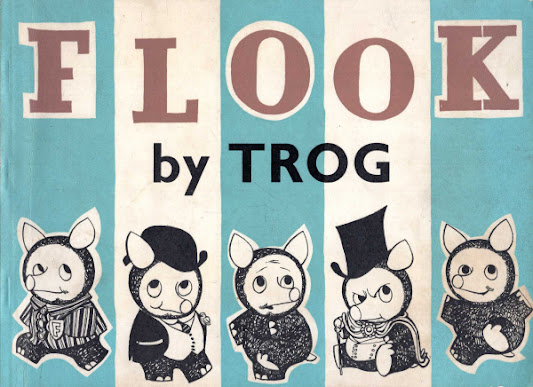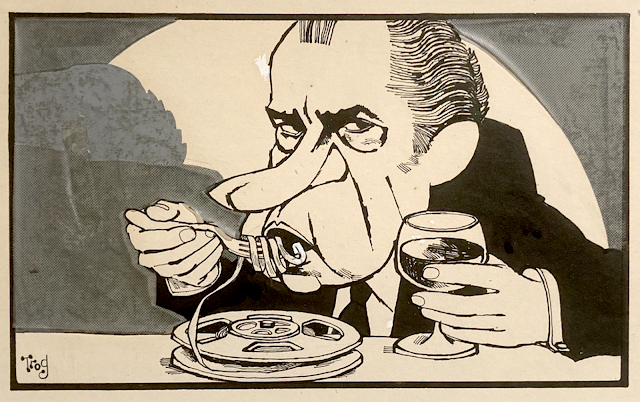From The British Cartoon Archive.
 |
Self-portrait |
Cartoonist and musician Wally Fawkes “Trog“ died peacefully, at 98, last Wednesday following a short illness.
A newspaper illustrator, comic strip artist and political cartoonist, he was also a renowned musician.
Walter Ernest ("Wally") Fawkes was born in Vancouver, on 21 June 1924, to Mabel (nee Ainsley) and Douglas Pearsall, a railway clerk.
After that marriage ended, Mabel and her children left for Britain with Wally’s stepfather, Charles Fawkes, a printer, in 1931.
After the outbreak of war in 1939 he was employed painting camouflage on factory roofs at the Woolwich docks to protect them against bombing.
Then, in 1942 he was "discovered" in a Coal Commission art competition judged by the Daily Mail's political cartoonist, Leslie Illingworth.
Fawkes' pen name had its origins in the war.
In January 1948, playing clarinet, he joined Humphrey Lyttelton and His Band, which soon became the leading traditional jazz band in Britain.
Fawkes drew "Flook" for the Daily Mail for thirty-five years, assisted by various authors including Robert Raymond in 1951 and 1952, Compton Mackenzie in 1953, Humphrey Lyttleton from 1953 to 1956, and singer George Melly from 1956 to 1971.
His marriage to Sandy Fawkes produced four children, with Johanna, Kate and Jamie surviving.
As he later admitted, this did not prove to be a success: "I finished work one Friday, came back on Monday and it had been flattened. It is the harshest criticism of my work I have faced."
Then, in 1942 he was "discovered" in a Coal Commission art competition judged by the Daily Mail's political cartoonist, Leslie Illingworth.
In June 1945, on his twenty-first birthday, Illingworth found him a job on the Daily Mail, drawing column-breakers and decorative illustrations.
"We spent so much time in air raid shelters," he later recalled, "I used to joke we in London had become troglodytes."
One of his own early jazz bands was called "The Troglodytes", and this transferred into the pseudonym "Trog".
His comic strip "Rufus", named after the red-headed boy who featured in the strip, was launched on 25 April 1949.
After Rufus discovered Flook - a magical creature that at first could only say "flook" - the strip became "Rufus and Flook," and finally just "Flook."
Fawkes drew "Flook" for the Daily Mail for thirty-five years, assisted by various authors including Robert Raymond in 1951 and 1952, Compton Mackenzie in 1953, Humphrey Lyttleton from 1953 to 1956, and singer George Melly from 1956 to 1971.
 |
| Wally Fawkes, right, checking sketches for the Flook strip with Daily Mail colleagues in 1951.Photograph: Hulton Deutsch/Corbis/Getty Images |
Fawkes began contributing political cartoons to the Spectator in 1959.
Fawkes also began to draw larger political cartoons for the Daily Mail, but in 1965 his progress at the paper was blocked by the arrival of Gerald Scarfe, who was seen as a potential successor to Illingworth.
However, by 1967 it was clear that Scarfe was not happy at the Daily Mail, and Fawkes' position on the paper became more secure.
At the end of 1969 Illingworth retired as the Daily Mail's political cartoonist and Fawkes took ove, recalling that "it was great fun."
In 1971 Fawkes returned to the Observer, to draw two cartoons a week - a large political cartoon for the leader page, and a "Mini-Trog" for the front page.
At the same time his work was still appearing in Punch, where he had replaced Illingworth as political cartoonist in 1969, and had drawn his first cover.
In the Daily Mail Fawkes introduced a grisaille tonal style using gouache, and subsequently employed a variety of techniques, notable successes being his striking colour caricature covers for Punch.
Fawkes continued to draw "Flook" for the Daily Mail, but grew disillusioned with the paper's politics.
Fawkes continued to provide cartoons for Punch and Private Eye, and also began a regular pocket cartoon - "Mini-Trog" - for the Observer.
From 1961 to 1964 Fawkes was also an occasional contributor to Private Eye, and in 1962 he began contributing to the New Statesman, where he and George Melly pushed the boundaries of cartoons on royalty.
Fawkes also began to draw larger political cartoons for the Daily Mail, but in 1965 his progress at the paper was blocked by the arrival of Gerald Scarfe, who was seen as a potential successor to Illingworth.
However, by 1967 it was clear that Scarfe was not happy at the Daily Mail, and Fawkes' position on the paper became more secure.
However, in 1971 the Daily Mail absorbed the old Daily Sketch, whose editor, David English, took charge of the combined paper and was given the job of transforming it into a tabloid.
The Daily Sketch cartoonist, Stan McMurtry "Mac" was given the job on the political page and Fawkes was dropped instantly.
In 1971 Fawkes returned to the Observer, to draw two cartoons a week - a large political cartoon for the leader page, and a "Mini-Trog" for the front page.
 |
| Edward Heath and Georges Pompidou recall greater predecessors. |
Fawkes continued to draw "Flook" for the Daily Mail, but grew disillusioned with the paper's politics.
In July 1984, after more than 10,000 consecutive strips, Fawkes was given three months' notice.
Fawkes continued to provide cartoons for Punch and Private Eye, and also began a regular pocket cartoon - "Mini-Trog" - for the Observer.
However, in 1996 he left the Observer for the Sunday Telegraph, another change of political tone which he joked was "like working deep behind enemy lines."
In 1997 Fawkes also began producing covers for The Week, and was presented with the Cartoon Art Trust's Lifetime Achievement Award.
In 2001 he received an Honorary Doctorate from the University of Kent.
His marriage to Sandy Fawkes produced four children, with Johanna, Kate and Jamie surviving.
UPDATE
Wally Fawkes obituary" in The Guardian.

.jpg)











No comments:
Post a Comment